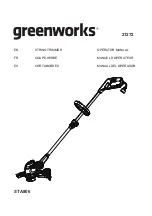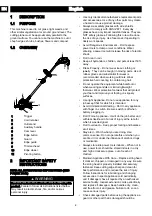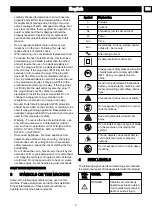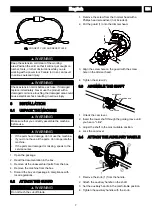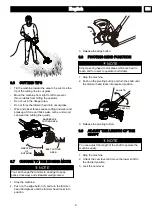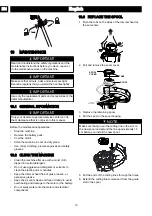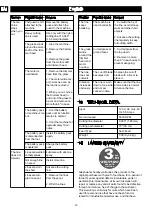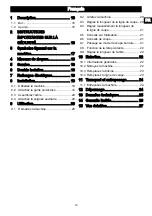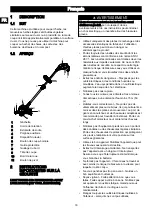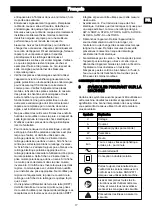
SYM-
BOL
SIGNAL
MEANING
WARNING
Indicates a potentially haz-
ardous situation,which, if
not avoided, could result in
death or serious injury.
CAUTION
Indicates a potentially haz-
ardous situation, which, if
not avoided, may result in
minor or moderate injury.
CAUTION
(Without Safety Alert Sym-
bol) Indicates a situation
that may result in property
damage.
5
SERVICE
Servicing requires extreme care and knowledge and
must be performed only by a qualified service
technician. For service we suggest you return the
machine to your nearest AUTHORIZED SERVICE
CENTER for repair. Use only identical manufacturer’s
replacement parts and accessories.
6
DOUBLE INSULATED
Double insulation is a concept in safety in electric power
tools, which eliminates the need for the usual threewire
grounded power cord. All exposed metal parts are
isolated from the internal metal motor components with
protecting insulation. Double insulated tools do not need
to be grounded.
WARNING
The double insulated system is intended to protect the
user from shock resulting from a break in the tool’s
internal insulation. Observe all normal safety
precautions to avoid electrical shock.
NOTE
Servicing of a product with double insulation requires
extreme care and knowledge of the system and
should be performed only by a qualified service
technician. For service, we suggest you return the tool
to your nearest authorized service center for repair.
Always use original factory replacement parts when
servicing.
7
EXTENTION CORDS
When using a power tool at a considerable distance
from a power source, be sure to use an extension cord
that has the capacity to handle the current the product
will draw. An undersized cord will cause a drop in line
voltage, resulting in overheating and loss of power. Use
the chart to determine the minimum wire size required in
an extension cord. Only round jacketed cords listed by
Underwriter’s Laboratories (UL) should be used.
When working outdoors with a product , use an
extension cord that is designed for outside use. This
type of cord is designated with “W-A” or “W” on the
cord’s jacket. Before using any extension cord, inspect it
for loose or exposed wires and cut or worn insulation.
MINIMUM GAUGE FOR EXTENSION CORDS (AWG)
(WHEN USING 120 V ONLY)
Ampere Rating
Total Length of Cord in Feet (me-
ters)
More
Than
Not
More
Than
25' (7.6
m)
50' (15
m)
100'
(30.4
m)
150'
(45.7
m)
0
6
18
16
16
14
6
10
18
16
14
12
10
12
16
16
14
12
12
16
14
12
Not Recommen-
ded
Extension Cord – Make sure your extension cord is in
good condition. When using an extension cord, be sure
to use one heavy enough to carry the current your
product will draw. An undersized extension cord will
cause a drop in voltage resulting in loss of power and
overheating. The table shows the correct size to use
depending on cord length and name plate ampere
rating. If in doubt, use the next heavier gauge. The
smaller the gauge number, the heavier the cord. To
reduce the risk of disconnection of appliance cord from
the extension cord during operating:
1. Make a knot as shown in Figure A. or
2. Use one of the plug-receptacle retaining straps or
connectors.
METHOD OF SECURING EXTENSION CORD
THE CORD AS SHOWN
6
English
EN

